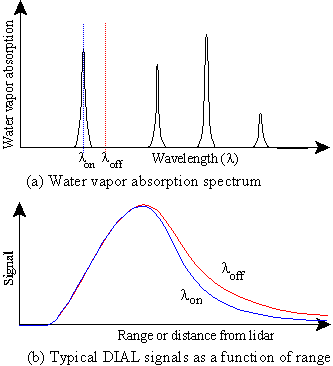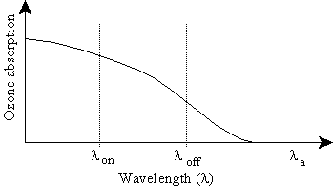A .gov website belongs to an official government organization in the United States.
A lock () or https:// means you've safely connected to the .gov website. Share sensitive information only on official, secure websites.
Light is absorbed by many of the atmospheric components. Absorption of light by molecules is the basis for DIAL which is used to measure the atmospheric concentrations of gases such as water vapor and ozone. More about LIDAR


As shown in figure (a), water vapor has many discrete absorption lines. In water vapor DIAL, laser pulses are transmitted at two wavelengths, one on a water vapor absorption line, λon, and another off-line, λoff. If the two wavelengths are close together, then for both wavelengths the scattering by molecules and particles is essentially equal. The difference in the returns between the two wavelengths is then due entirely to absorption by water vapor molecules, figure (b). Thus, measurement of the ratio of the backscatter at the two wavelengths as a function of range can be used to calculate the water vapor concentration profile.
DIAL measurements of ozone require less precise laser frequency because ozone has a broad (~200 nm) absorption band [see figure] instead of narrow lines lines like water vapor. This requires that the on- and off- wavelengths be chosen with sufficient wavelength separation to ensure a significant difference in their absorption. However, uncertainty in the changes of aerosol scattering and patterning between the wavelengths can introduce error. The difference in aerosol scattering at λon and λoff can be extrapolated from a third measurement taken at a longer wavelength, λa. Therefore, DIAL measurements with three wavelengths can be used to determine ozone concentration profiles to good accuracy.